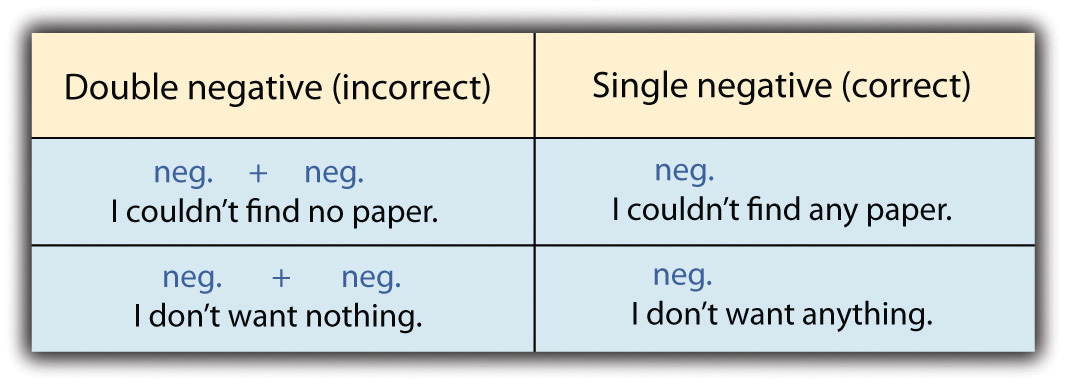This is “Negative Statements”, section 4.2 from the book English for Business Success (v. 1.0). For details on it (including licensing), click here.
For more information on the source of this book, or why it is available for free, please see the project's home page. You can browse or download additional books there. To download a .zip file containing this book to use offline, simply click here.
4.2 Negative Statements
Learning Objectives
- Identify a negative statement.
- Write negative statements.
NegativeA sentence or phrase that expresses the opposite of a positive statement. statements are the opposite of positive statements and are necessary to express an opposing idea. The following charts list negative words and helping verbsA verb that is used with a main verb to describe mood or tense. The helping verb is usually a form of be, do, or have. that can be combined to form a negative statement.
| Negative Words | ||
|---|---|---|
| never | no | hardly |
| nobody | none | scarcely |
| no one | not | barely |
| nowhere | rarely | |
| Common Helping Verbs | ||
|---|---|---|
| am | is | are |
| was | were | be |
| being | been | have |
| has | had | do |
| does | did | can |
| could | may | might |
| must | will | should |
| would | ought to | used to |
The following examples show several ways to make a sentence negative in the present tense.
-
A helping verb used with the negative word not.
Sentence: My guests are arriving now.
Negative: My guests are not arriving now.
-
The negative word no.
Sentence: Jennie has money.
Negative: Jennie has no money.
-
The contraction n’t.
Sentence: Janetta does miss her mom.
Negative: Janetta doesn’t miss her mom.
-
The negative adverb rarely.
Sentence: I always go to the gym after work.
Negative: I rarely go to the gym after work.
-
The negative subject nobody.
Sentence: Everybody gets the day off.
Negative: Nobody gets the day off.
Exercise 1
On a separate sheet of paper, rewrite the positive sentences as negative sentences. Be sure to keep the sentences in the present tense.
- Everybody is happy about the mandatory lunch.
- Deborah likes to visit online dating sites.
- Jordan donates blood every six months.
- Our writing instructor is very effective.
- That beautiful papaya is cheap.
The following sentences show you the ways to make a sentence negative in the past tense.
Sentence: Paul called me yesterday.
Negative: Paul did not call me yesterday.
Sentence: Jamilee went to the grocery store.
Negative: Jamilee never went to the grocery store.
Sentence: Gina laughed when she saw the huge pile of laundry.
Negative: Gina did not laugh when she saw the huge pile of laundry.
Notice that when forming a negative in the past tense, the helping verb did is what signals the past tense, and the main verb laugh does not have an -ed ending.
Exercise 2
Rewrite the following paragraph by correcting the errors in the past-tense negative sentences.
Celeste no did call me when she reached North Carolina. I was worried because she not drove alone before. She was going to meet her friend, Terry, who lived in a town called Asheville, North Carolina. I did never want to worry, but she said she was going to call when she reached there. Finally, four hours later, she called and said, “Mom, I’m sorry I did not call. I lost track of time because I was so happy to see Terry!” I was relieved.
Collaboration
Once you have found all the errors you can, please share with a classmate and compare your answers. Did your partner find an error you missed? Did you find an error your partner missed? Compare with your instructor’s answers.
Double negativesTwo negatives used in the same phrase or sentence. are two negatives used in the same phrase or sentence. They are considered incorrect in Standard English. You should avoid using double negatives in all formal writing. If you want to say something negative, use only one negative word in the sentence. Return to the beginning of this section for a list of negative words, and then study the following examples.

Tip
Ain’t is considered a contraction of am not. Although some may use it in everyday speech, it is considered incorrect in Standard English. Avoid using it when speaking and writing in formal contexts.
Exercise 3
On your own sheet of paper, correct the double negatives and rewrite the following sentences.
- Jose didn’t like none of the choices on the menu.
- Brittany can’t make no friends with nobody.
- The Southwest hardly had no rain last summer.
- My kids never get into no trouble.
- I could not do nothing about the past.
Key Takeaways
- Negatives are usually formed using a negative word plus a helping verb.
- Double negatives are considered incorrect in Standard English.
- Only one negative word is used to express a negative statement.
Writing Application
Write a paragraph describing your favorite meal. Use rich, colorful language to describe the meal. Exchange papers with a classmate and read his or her paragraph. Then rewrite each sentence of your classmate’s paragraph using negatives. Be sure to avoid double negatives. Share your negative paragraphs with each other.




